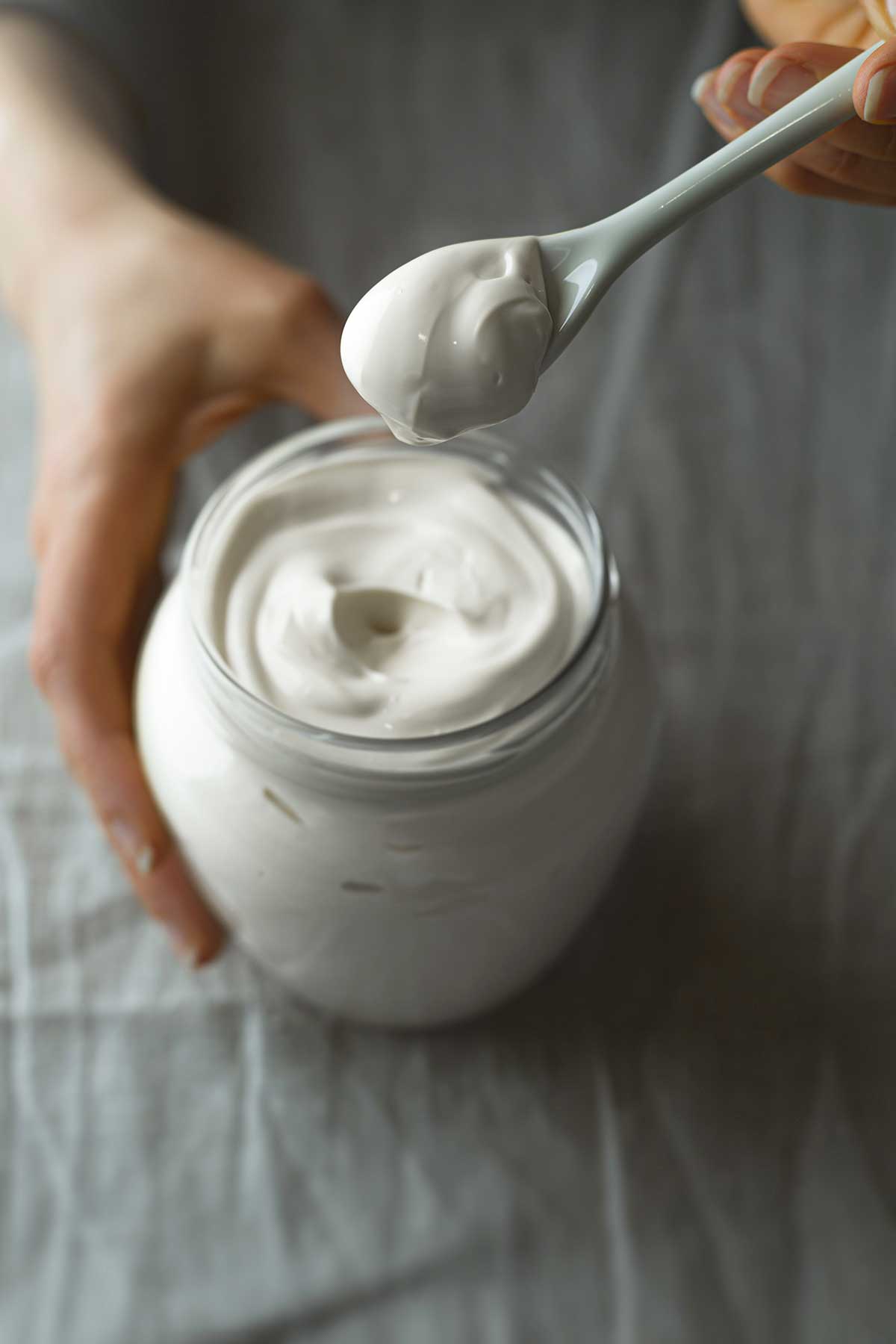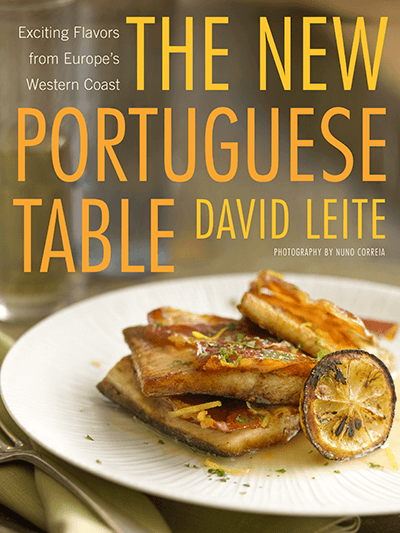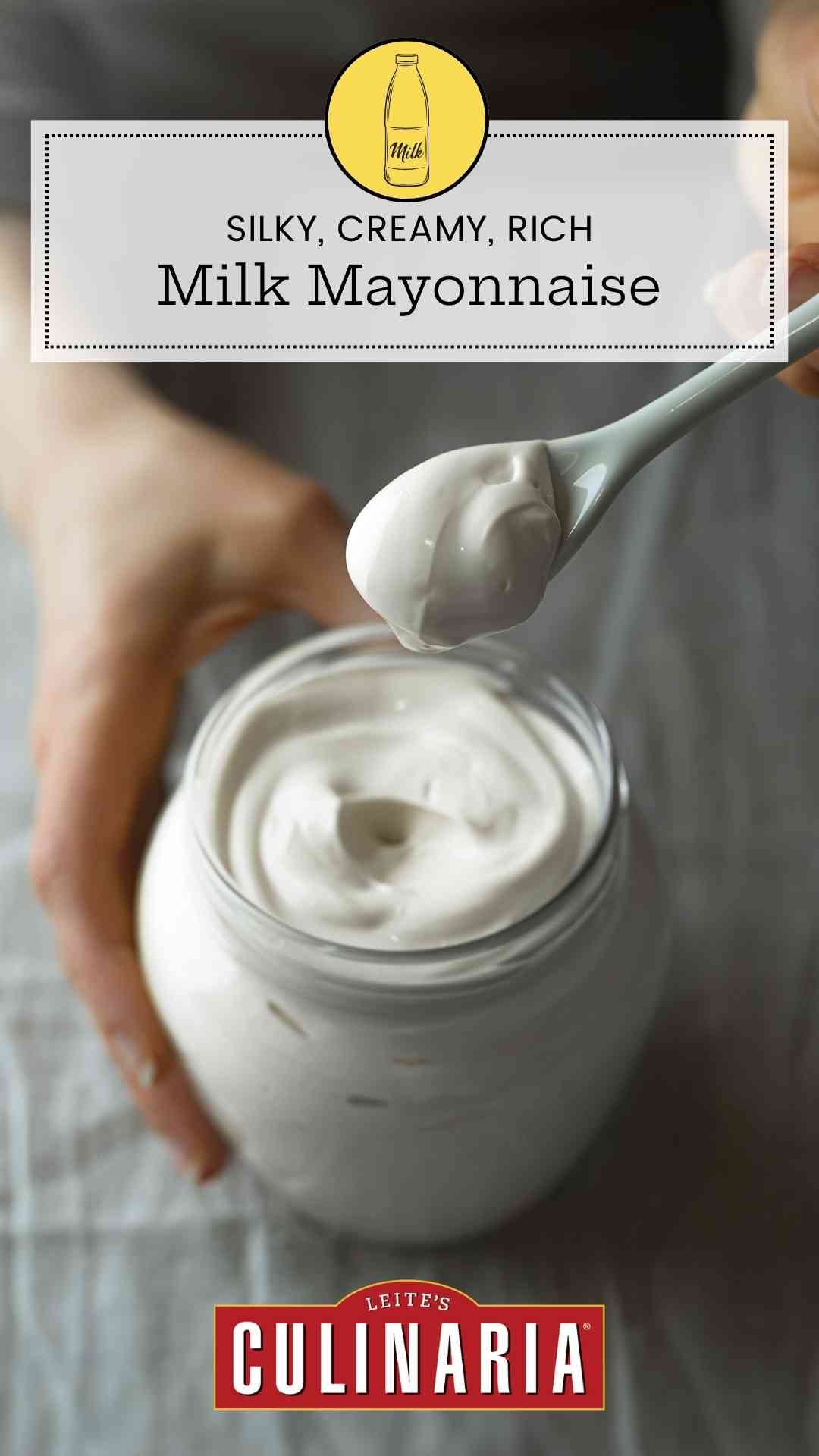
This is one of those recipes that require quotation marks, not out of affectation, but because it’s not a true mayonnaise. It contains no egg yolks or mustard. It’s nothing more than an emulsion of milk and oil. More Brazilian than Portuguese, it’s just now beginning to be used on the Continent. The taste is lighter and cleaner than that of egg-based mayonnaise, allowing other flavors to come through.
☞ Read the Article: The Secret Behind Milk Mayonnaise
Since I was given the recipe, I haven’t stopped finding ways to cook with it. The master recipe is only a canvas for additions. Besides the uses in this book, I’ve smeared the variations on grilled meats and fish, used them as dips and in dressings, spread them on sandwiches, and stirred them into potato salads, much as I do with actual mayonnaise.
Why Isn’t my Mayonnaise Emulsifying?
Like all emulsions, this recipe can be a bit finicky. But adding the oil in a thin stream and stopping when the right consistency is reached is the key. For almost foolproof results, a handheld blender is best, but a small canister blender with a narrow base will do (tall and narrow is best here). Don’t do as some of us did and assume that a stand mixer or food processor will work—it just won’t. If you’re working with a less-than-powerful immersion blender, the consistency of the mayonnaise may turn out thinner than you’d expect. You can help it along by slowly adding 2 more tablespoons of oil to the milk mayonnaise as you continue to blend and it will thicken nicely.

Milk Mayonnaise
Ingredients
- ⅓ cup very cold milk
- ¾ teaspoon fresh lemon juice
- 1 small garlic clove, peeled
- ⅛ teaspoon white pepper
- About ¾ cup vegetable oil, or 1/2 cup (118 ml) vegetable oil plus 1/4 cup (60 ml) olive oil
- Kosher salt
Instructions
- Combine the milk, lemon juice, garlic, and pepper in a 2-cup glass measuring cup. Using a handheld blender (or a blender), buzz on high for 30 seconds until frothy.
- With the motor running on high, slowly pour in the oil a few drops at a time, and gradually increase this to a fine thread, moving the blender up and down, until the mixture thickens lusciously and resembles a soft mayonnaise. You may need more or less oil.
- Season with salt to taste. The mayonnaise will last up to 1 week in the fridge.
Notes
Milk mayonnaise variations
Clockwise from top right: cilantro-ginger, curry, anchovy, sun-dried tomato.
Cilantro and Ginger Milk Mayonnaise | Maionese de Leite com Coentros e Gengibre
Add 1 loosely packed cup of well-dried fresh cilantro leaves and tendril-soft stems and a 1 1/2-inch peeled and grated thumb of ginger to the cup along with the milk, 1 3/4 teaspoons of lemon juice, and the pepper. Omit the garlic. Whir in the oil as directed above. Stir in 1 scallion cut into thin slices on the diagonal.Anchovy Milk Mayonnaise | Maionese de Leite com Anchovas
Add 6 anchovy fillets (generous 1 tablespoon) packed in oil to the cup along with the milk, lemon juice, garlic, and pepper. Whir in the oil as directed above. Omit the salt.Curry Milk Mayonnaise | Maionese de Leite com Caril
Add 2 teaspoons of your favorite curry powder to the cup along with the milk, lemon juice, garlic, and pepper. Whir in the oil as directed above. Before using, let this sit for an hour or so in the fridge to bloom.Tomato Milk Mayonnaise | Maionese de Leite com Tomate
Add 1 1/2 tablespoons of double-concentrate tomato paste to the cup along with the milk, garlic, and pepper. Omit the lemon juice. Whir in the oil as directed above. Stir in 1 tablespoon minced oil-packed sun-dried tomatoes.
Nutrition
Nutrition information is automatically calculated, so should only be used as an approximation.











Well, obviously I need to buy your book. I swore I would take a few months off (I had gone on quite a cookbook binge), but since finding your blog my will power has been seriously put to the test and I now throw in the towel!
Well, Tammi, if you do, please tell me what you think. And I’m here to answer any questions.
First of all I love your usage of the word “plonk.” Now my dilemma is which recipe to try first! Your book is amazing, I must admit after receiving it, I skimmed through a fair amount of the first chapters to look at the recipes. (I got it when I came home from the office this afternoon.) They all look amazing, and the photography adds to the experience. I’m a little concerned about procuring some of the ingredients here in Lancaster, PA but I can’t wait to start.
Tammi, thank you so much for your kind words. I think you’ll find there are very few special ingredients you’ll need for the book. I included a chapter at the end that shows you how to make 90% of those special ingredients. The appendix also includes a mail order list of place from which you can buy any of the items you need. And if you ever have any question about a recipe, don’t hesitate to ask.
Thanks for the update, David, I’ve been wanting to try this recipe ever since buying your cookbook. Loved the idea of adding green olives to the milk mayo, ended up pureeing the olives with the rest of the initial ingredients for completely delicious results, enough so that I was reluctant to share with anyone else. What made it really interesting was that I used avocado oil from a trip to Southern California, which with the green of the olives imparted a haunting/addicting flavor that was like guacamole, but not. So along with the different flavorings you offer here, the choice of oil (I’m thinking other nut oils such as walnut or hazelnut) also changes things up to definite taste advantage!
Debra, absolutely. People have used olive oil, avocado oil, walnut oil, almond oil, grape seed oil, coconut oil, hazelnut oil, macadamia oil, lemon oil…the list goes on and on. I have to try your trick of puree the oils with the milk and garlic.
I’ve never heard of milk mayo, but i am going to try it soon, and i have a hand held blender so this might end up being my go-to when i want to make some dressing without making a lot of dressing that won’t be eaten!!! Thanks so much for the recipe, Frances Barker….
You bet, Frances. And let me know what you think.